Yamaha RX-V495RDS User Manual

B G
RX-V495RDS
Natural Sound AV Receiver
Ampli-Tuner Audio-Video
OWNER’S MANUAL MODE D’EMPLOI BEDIENUNGSANLEITUNG BRUKSANVISNING MANUALE DI ISTRUZIONI MANUAL DE INSTRUCCIONES GEBRUIKSAANWIJZING

SUPPLIED ACCESSORIES ACCESSOIRES FOURNIS MITGELIEFERTE ZUBEHÖRTEILE MEDFÖLJANDE TILLBEHÖR ACCESSORI IN DOTAZIONE ACCESORIOS INCLUIDOS BIJGELEVERDE ACCESSOIRES
•After unpacking, check that the following parts are included.
•Après le déballage, vérifier que les pièces suivantes sont incluses.
•Nach dem Auspacken überprüfen, ob die folgenden Teile vorhanden sind.
•Kontrollera efter uppackningen att följande delar finns med.
•Verificare che tutte le parti seguenti siano contenute nell’imballaggio dell’apparecchio.
•Desembalar el aparato y verificar que los siguientes accesorios están en la caja.
•Controleer na het uitpakken of de volgende onderdelen voorhanden zijn.
•Indoor FM Antenna
•Antenne FM intérieure
• UKW-Innenantenne
• Inomhus-FM-antenn
•Antenna FM interna
•Antena FM interior
•FM-binnenantenne
•AM Loop Antenna
•Cadre-antenne AM
•MW-Rahmenantenne
•AM-ramantenn
•Antenna AM ad anello
• Antena de cuadro de AM
• AM-raamantenne
•75-ohm/300-ohm antenna adapter (U.K. model only)
•Adaptateur d’antenne 75 ohms/300 ohms (Modèle Royaume-Uni seulement)
•75-Ohm/300-Ohm Antennenstecker (nur Großbritannien-Modell)
•75 ohm/300 ohm antennadapter
(gäller endast modellen för Storbritannien)
•Adattatore per antenna da 75 e 300 ohm (Soltanto il modello per la Gran Bretagna)
•Adaptador de antena de 75-ohmios/300-ohmios (Sólo el modelo para el Reino Unido)
•75 ohm/300 ohm antenneadapter
(Alleen modellen voor Verenigd Koninkrijk)
•Batteries (size AAA, R03, UM-4)
•Piles (taille AAA, R03, UM-4)
•Batterien (Größe AAA, R03, UM-4)
•Batterier
(storlek AAA, R03, UM-4)
• Batterie
(formato AAA, R03, UM-4)
•Pilas (tamaño AAA, R03, UM-4)
•Batterijen (maat AAA, R03, UM-4)
•Remote control transmitter
•Télécommande
•Fernbedienung
•Fjärrkontroll
•Telecomando
•Transmisor de control remoto
•Afstandsbediening
2

FEATURES
●5-Channel Power Amplification Minimum RMS Output Power <0.04% THD, 20 Hz – 20 kHz>
Main: 60 W + 60 W (8 Ω)
Center: 60 W (8 Ω)
Rear: 60 W + 60 W (8 Ω)
●Digital Sound Field Processor
●Dolby Digital Decoder
●Dolby Pro Logic Surround Decoder
●CINEMA DSP: Theater-like Sound Experience by the Combination of Dolby Surround and YAMAHA DSP Technology
●6-Channel External Decoder Input for DTS and other future formats
●Automatic Input Balance Control for Dolby Pro Logic Surround
●Test Tone Generator for Easier Speaker Balance Adjustment
●Speaker Output Mode Changing Capability
●40-Station Random Access Preset Tuning
●Automatic Preset Tuning
●Preset Station Shifting Capability (Preset Editing)
●Video Signal Input/Output Capability
●SLEEP Timer
●Universal Remote Control Transmitter with Preset Manufacturer Codes
English
CONTENTS
SUPPLIED ACCESSORIES........................................... |
2 |
FEATURES .................................................................... |
3 |
CAUTION ....................................................................... |
4 |
●Information about DSP |
|
USING THE DIGITAL SOUND FIELD |
|
PROCESSOR (DSP) .............................................. |
41 |
●Introduction |
|
FEATURES OF SOUND EFFECTS ............................... |
5 |
CONTROLS AND THEIR FUNCTIONS ......................... |
7 |
●Preparation |
|
SPEAKER SETUP ....................................................... |
12 |
CONNECTIONS ........................................................... |
14 |
ADJUSTMENTS |
|
BEFORE USING THIS UNIT .................................. |
21 |
●Basic Operation |
|
BASIC OPERATIONS .................................................. |
26 |
TUNING OPERATIONS ............................................... |
30 |
RECEIVING RDS STATIONS ...................................... |
35 |
SETTING THE SLEEP TIMER ..................................... |
40 |
●Advanced Information |
|
ADJUSTMENTS |
|
IN THE “SET MENU” MODE ................................... |
47 |
●Remote Control Transmitter |
|
REMOTE CONTROL TRANSMITTER ......................... |
49 |
SETUP CODES ........................................................... |
56 |
TROUBLESHOOTING ................................................. |
57 |
SPECIFICATIONS ....................................................... |
59 |
LIST OF MANUFACTURER’S CODES ...................... |
411 |
3
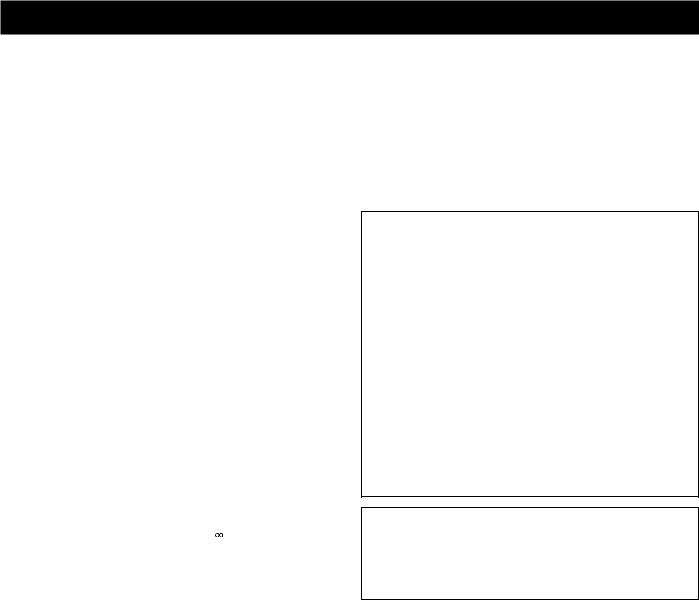
CAUTION: READ THIS BEFORE OPERATING YOUR UNIT.
1.To assure the finest performance, please read this manual carefully. Keep it in a safe place for future reference.
2.Install this unit in a cool, dry, clean place – away from windows, heat sources, sources of excessive vibration, dust, moisture and cold. Avoid sources of humming (transformers, motors). To prevent fire or electrical shock, do not expose the unit to rain or water.
3.Never open the cabinet. If something drops into the set, contact your dealer.
4.Do not use force on switches, controls or connection wires. When moving the unit, first disconnect the power plug and the wires connected to other equipment. Never pull the wires themselves.
5.The openings on the unit cover assure proper ventilation of the unit. If these openings are obstructed, the temperature inside the unit will rise rapidly. Therefore, avoid placing objects against these openings, and install the unit in a well-ventilated area to prevent fire and damage.
Be sure to allow a space of at least 20 cm behind, 20 cm on the both sides and 30 cm above the top panel of the unit to prevent fire and damage.
6.The voltage used must be the same as that specified on this unit. Using this unit with a higher voltage than specified is dangerous and may result in fire or other accidents. YAMAHA will not be held responsible for any damage resulting from use of this unit with a voltage other than specified.
7.Digital signals generated by this unit may interfere with other equipment such as tuners, receivers or TVs. Move this unit farther away from such equipment if interference is observed.
8.Always set the VOLUME control to “ ” before starting the audio source play. Increase the volume gradually to an appropriate level after playback has been started.
9.Do not attempt to clean the unit with chemical solvents; this might damage the finish. Use a clean, dry cloth.
10.Be sure to read the “TROUBLESHOOTING” section regarding common operating errors before concluding that the unit is faulty.
11.When not planning to use this unit for long periods of time (ie., vacation, etc.), disconnect the AC power plug from the wall outlet.
12.To prevent lightning damage, disconnect the AC power plug and disconnect the antenna cable when there is an electrical storm.
13.Grounding or polarization – Precautions should be taken so that the grounding or polarization of an appliance is not defeated.
14.AC outlet
Do not connect audio equipment to the AC outlet on the rear panel if that equipment requires more power than the outlet is rated to provide.
For U.K. customers
If the socket outlets in the home are not suitable for the plug supplied with this appliance, it should be cut off and an appropriate 3 pin plug fitted. For details, refer to the instructions described below.
Note: The plug severed from the mains lead must be destroyed, as a plug with bared flexible cord is hazardous if engaged in a live socket outlet.
Special Instructions for U.K. Model
IMPORTANT
THE WIRES IN MAINS LEAD ARE COLOURED IN ACCORDANCE WITH THE FOLLOWING CODE:
Blue: NEUTRAL
Brown: LIVE
As the colours of the wires in the mains lead of this apparatus may not correspond with the coloured markings identifying the terminals in your plug, proceed as follows: The wire which is coloured BLUE must be connected to the terminal which is marked with the letter N or coloured BLACK. The wire which is coloured BROWN must be connected to the terminal which is marked with the letter L or coloured RED.
Making sure that neither core is connected to the earth terminal of the three pin plug.
This unit is not disconnected from the AC power source as long as it is connected to the wall outlet, even if this unit itself is turned off. This state is called the standby mode. In this state, this unit is designed to consume a very small quantity of power.
4

FEATURES OF SOUND EFFECTS
Introduction
Welcome to the exciting world of digital home entertainment. This unit is one of the most complete and advanced AV receivers available. Some of the more advanced features may not be familiar to you, but they are easy to use. State-of-the-art technologies such as Dolby Digital and Digital Theater Systems (DTS) may be new to your home, but you have probably experienced the amazing realism they bring to feature films in theaters around the world.
To make the listening experience even more enjoyable, this unit includes a number of exclusive, digitally created listening environments known as digital sound fields. Choosing a sound field program is like transporting yourself to such venues as an outdoor arena, a European church, or a cozy jazz club. Take some time now to read more about these features and enjoy the new experiences this unit brings to your home theater.
Digital Sound Field Processing
What is it that makes live music so good? Today’s advanced sound reproduction technology lets you get extremely close to the sound of a live performance, but the chances are that you’ll still notice something missing — the acoustic environment of the live concert hall. Extensive research into the exact nature of the sonic reflections that create the ambience of a large hall has made it possible for YAMAHA engineers to bring you this same sound to your listening room, so you’ll feel all the sound of a live concert.
Furthermore, our technicians, armed with sophisticated measuring equipment, have even made it possible to capture the acoustics of a variety of actual concert halls, theaters, etc. from around the world, to allow you to accurately re-create any one of these live performance environments, all in your own home.
Dolby Pro Logic Surround
Dolby Surround has been used in movie theaters since the midseventies. It has also been available in home entertainment systems since the late eighties and continues to be a popular format for home theater systems. It uses four discrete channels and five speakers to reproduce realistic and dynamic sound effects: two main channels (left and right), a center channel for dialog, and a rear channel for special sound effects. The rear channel reproduces sound within a narrow frequency range.
Most video tapes and laser discs include Dolby Surround encoding, as do many TV and cable broadcasts. The Dolby Pro Logic Surround decoder built into this unit employs a digital signal processing system that stabilizes each channel for even more accurate sound positioning than is available with standard analog processors.
Dolby Digital
The built-in Dolby Digital decoder leads you into a totally new sound experience.
Dolby Digital is a new generation of multi-channel digital audio technology, or the newest spatial sound processing format developed for 35 mm-film movies by employing a new kind of low bit-rate audio coding.
Dolby Digital is a digital surround sound system that provides completely independent multi-channel audio to listeners. In multi-channel form, Dolby Digital provides 5 full-range channels in what is sometimes referred to as a “3/2” configuration: three front channels (left, center and right), plus two surround channels. A sixth bass-only effect channel is also provided for output of LFE (low frequency effect), or low bass effects that are independent of other channels. This channel is counted as 0.1, thus giving rise to the term 5.1 channels in total.
Compared to Dolby Pro Logic, which is referred to a “3/1” system (left front, center, right front and just one surround channel), Dolby Digital features two surround channels, called stereo or split surrounds, each offering the same full-range fidelity as the three front channels.
Sound of wide dynamic range reproduced by the 5 full-range channels provides listeners with excitement that has never been experienced before. Precise sound orientation by discrete digital sound processing expands the realism that the original movie possesses.
LD and DVD are home audio/video program source that could benefit from Dolby Digital. In the near future, Dolby Digital will also be applied to DBS, CATV and HDTV. The ongoing release of Dolby Digital theatrical films now underway will provide an immediate source of Dolby Digital encoded video software.
English
5
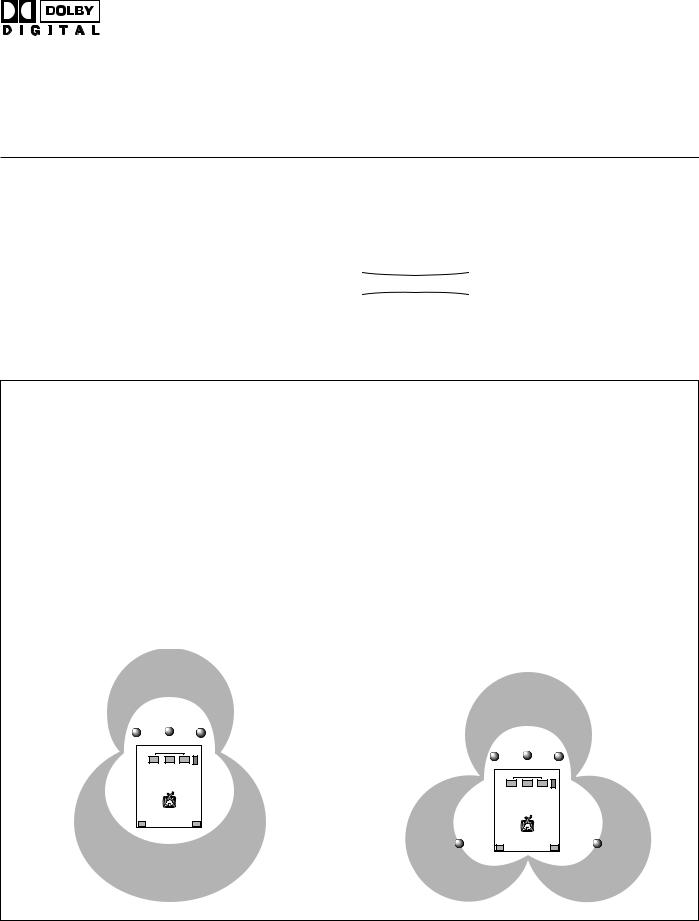
The following original functions make the surround-sound effect of Dolby Digital become the most suitable for your audio system and the listening conditions.
Manufactured under license from Dolby Laboratories. “Dolby”, “Pro Logic” and the double-D symbol are trademarks of Dolby Laboratories.
CINEMA DSP: Dolby Surround + DSP
The Dolby Surround sound system shows its full ability in a large movie theater, because movie sounds are originally designed to be reproduced in a large movie theater using many speakers. It is difficult to create a sound environment similar to that of a movie theater in your listening room, because the room size, materials of inside walls, the number of speakers, etc. of your listening room are very different from those of a movie theater.
YAMAHA DSP technology made it possible to present you with nearly the same sound experience as that of a large movie theater in your listening room by compensating for the lack of presence and dynamics in your listening room with its original digital sound fields combined with the Dolby Surround sound system.
CINEMA DSP
The YAMAHA “CINEMA DSP” logo indicates those programs that are created by the combination of Dolby Surround and YAMAHA DSP technology.
Dolby Pro Logic + 2 Digital Sound Fields
Digital sound fields are created on the presence side and the rear surround side of the Dolby Pro Logic Surround-decoded sound field, respectively. They create a wide acoustic environment and emphasize the surround effect in the room, letting you feel as much presence as if you are watching a movie in a popular Dolby Stereo theater.
This combination is available when the DOLBY PRO LOGIC ENHANCED/DOLBY DIGITAL ENHANCED, 70 mm MOVIE THEATER/DIGITAL MOVIE THEATER or TV SPORTS sound field program is selected, and the input signal of source is analog, PCM audio or encoded with Dolby Digital sound in 2-channel.
Dolby Digital + 3 Digital Sound Fields
Digital sound fields are created on the presence side and the independent left and right surround sides of the Dolby Digitaldecoded sound field, respectively. They create a wide acoustic environment and strong surround effect in the room without losing high-channel separation. With the wide dynamic range of Dolby Digital sound, this sound field combination lets you feel as if you are watching a movie in the newest Dolby Stereo Digital theater. This will be the most ideal home theater sound at the present time.
This combination is available when the DOLBY PRO LOGIC ENHANCED/DOLBY DIGITAL ENHANCED, 70 mm MOVIE THEATER/DIGITAL MOVIE THEATER or TV SPORTS sound field program is selected, and the input signal of source is encoded with Dolby Digital sound (except in 2-channel).
6
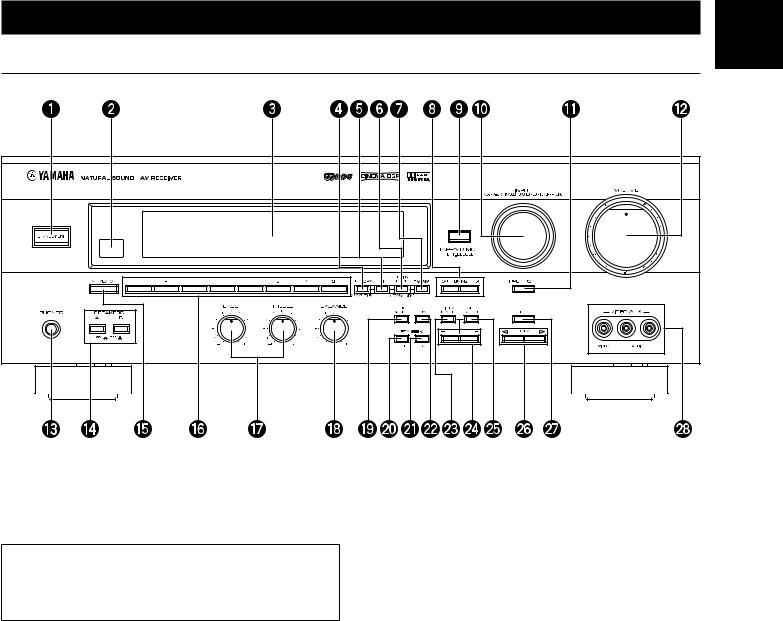
CONTROLS AND THEIR FUNCTIONS
FRONT PANEL
English
1STANDBY/ON
Press this switch to turn on the power to this unit. Press it again to set this unit to the standby mode.
Standby mode
In this state, this unit consumes a very small quantity of power to receive infrared-signals from the remote control transmitter.
2Remote control sensor
This receives signals from the remote control transmitter.
3Display
This shows various information. (Refer to page 9 for details.)
4MEMORY (MAN’L/AUTO FM)
Press this button to store the broadcasting stations. When this button is pressed and held for more than three seconds, the automatic preset tuning begins.
5EDIT
This button is used to exchange the assignment of two preset stations with each other.
6TUNING MODE (AUTO/MAN’L MONO)
Press this button to switch the tuning mode to automatic or manual. To select the automatic tuning mode, press this button so that the “AUTO TUNING” indicator lights up on the display. To select the manual tuning mode, press this button so that the “AUTO TUNING” indicator goes off.
7FM/AM
Press this button to switch the reception band to FM or AM.
8TUNING UP/DOWN
This button is used for tuning. Press the UP side to tune in to higher frequencies, and press the DOWN side to tune in to lower frequencies.
9TAPE/MD MON / EXT. DECODER
Press this button to play a tape or an MD. The “TAPE/MD MON” indicator lights up on the display.
When you press the button next, the “TAPE/MD MON” indicator goes off, “EXT. DECDR” appears on the display and you can play the signal connected to the EXTERNAL DECODER INPUT terminals.
0INPUT
Turn this selector to select the program source (VCR, VIDEO AUX, TV/DBS, DVD/LD, CD, TUNER, PHONO) to listen to or watch.
The name of the selected program source appears on the display.
7
qINPUT MODE
This button switches the DVD/LD and TV/DBS input signal mode (AUTO/ANALOG).
wVOLUME
This control is used to raise or lower the volume level.
ePHONES jack
When you use headphones, connect the headphones to the PHONES jack. You can listen to the sound to be output from the main speakers through the headphones.
When using headphones only, set both SPEAKERS A and B to the OFF position and switch off the digital sound field processor (so that no DSP program name appears on the display) by pressing EFFECT.
rSPEAKERS
Set A or B (or both A and B) to the ON position for the main speaker system (connected to this unit) that you want to use. Set the button(s) for the main speaker system you don’t want to use to the OFF position.
tA/B/C/D/E
Press this button to select one of a group (A to E) of preset stations.
yPreset station number selector
Each of these buttons selects a preset station number (1 to 8).
uTone controls
These controls are only effective for the sound from the main speakers.
BASS
Use this control to increase or decrease the low-frequency response. The “0” position produces flat response.
TREBLE
Use this control to increase or decrease the high-frequency response. The “0” position produces flat response.
iBALANCE
This control is only effective for the sound from the main speakers.
Turn the control to adjust the balance of the output volume to the left and right speakers to compensate for sound imbalance caused by the speaker location or listening room conditions.
oRDS MODE
When an RDS station is received, pressing this button changes the display into the PS mode, PTY mode, RT mode and/or CT mode (if the station employs those RDS data services) in turn.
pPTY SEEK MODE
When this button is pressed, the unit is set in the PTY SEEK mode.
aPTY SEEK START
Press this button to begin searching for a station after the desired program type has been selected in the PTY SEEK mode.
sEON
Press this button to select the desired program type (NEWS, INFO, AFFAIRS, SPORT) when you want to call a radio program of that type automatically.
dTIME/LEVEL
Press this button to select the item in the TIME/LEVEL mode.
f+/–
These buttons are used to adjust the settings of the SET MENU mode and the TIME/LEVEL mode. In the TIME/LEVEL mode, press + to increase the delay time or speaker output level. Press –to decrease the delay time or speaker output level.
gSET MENU
Press this button to select functions in the SET MENU mode.
hPROGRAM selector
Press  or
or  to select the DSP program.
to select the DSP program.
The name of the selected program appears on the display.
jEFFECT
This button switches on and off the output from the center and rear speakers so that the sound becomes the normal 2-channel.
*Even if the output from the center and rear speakers is off, when the Dolby Digital is decoded, the signals on all channels are distributed to the main channels and output from the main speakers.
kVIDEO AUX terminals
Connect an auxiliary video or audio input source unit such as a camcorder to these terminals. The source connected to these terminals can be selected by INPUT.
8
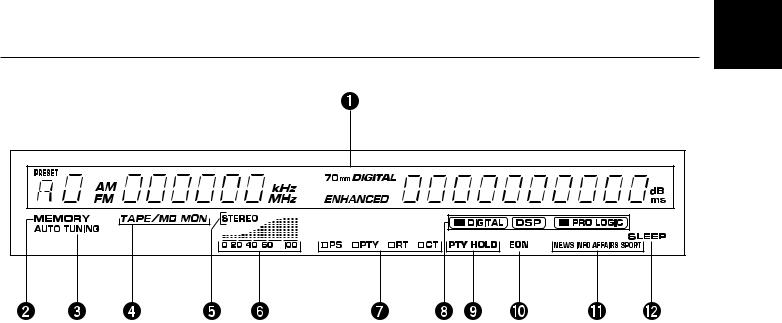
DISPLAY PANEL
English
1Multi-information display
This displays various information, for example the station frequency, preset station number and name of the selected program source.
2MEMORY indicator
When MEMORY is pressed, this indicator flashes for about five seconds. During this period, the displayed station can be stored in the memory.
3AUTO TUNING indicator
This lights up when the unit is in the automatic tuning mode.
4TAPE/MD MON indicator
This lights up when the tape deck (or MD recorder, etc.) is selected as the program source by pressing TAPE/MD MON / EXT. DECODER on the front panel or TAPE/MD on the remote control transmitter.
5STEREO indicator
This lights up when an FM stereo broadcast with sufficient signal strength is being received.
6Signal-level meter
This indicates the signal level of the station being received.
If multipath interference is detected, the indication decreases.
7RDS mode indicators
The name(s) of RDS mode(s) employed by the currently received RDS station light(s) up. Illumination of one of the named indicators shows that the corresponding RDS mode is now selected.
8 ,
,  and
and  indicators
indicators
“ ” lights up when the built-in Dolby Digital decoder is on and the signal of the selected source encoded in Dolby Digital sound is not in 2-channel. “
” lights up when the built-in Dolby Digital decoder is on and the signal of the selected source encoded in Dolby Digital sound is not in 2-channel. “ ” lights up when the built-in digital sound field processor is on, and “
” lights up when the built-in digital sound field processor is on, and “ ” lights up when the built-in Dolby Pro Logic Surround decoder is on. Depending on the selected DSP program, both “
” lights up when the built-in Dolby Pro Logic Surround decoder is on. Depending on the selected DSP program, both “ ” and “
” and “ ”, or both “
”, or both “ ” and “
” and “ ” will light up.
” will light up.
9PTY HOLD indicator
This lights up while a search is being performed in the PTY SEEK mode.
0EON indicator
This lights up when an RDS station that employs the EON data service is being received.
qProgram type name indicators
The name selected in the EON mode lights up.
wSLEEP indicator
This lights up while the built-in SLEEP timer is functioning.
9
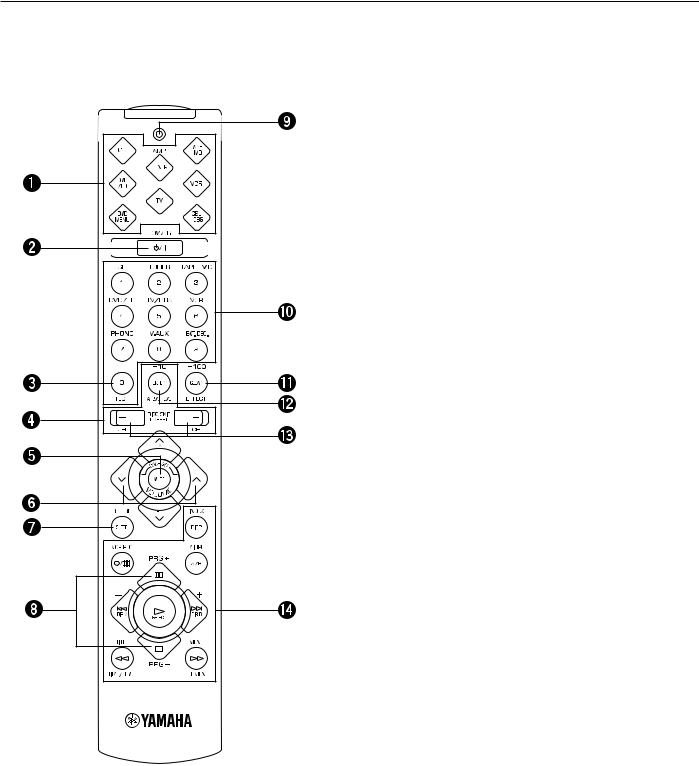
REMOTE CONTROL TRANSMITTER
See “REMOTE CONTROL TRANSMITTER” on page 49 for full details.
1Component selector
Press the button for the component you want to control with the remote control transmitter. (The proper code must be set for your component. See “SETUP CODES” on page 56.)
When the component selector has been pressed, the remote control transmitter is set to operate that component.
2POWER
When you have preset the code for a YAMAHA component, this button switches between the power on and standby mode. When you have preset the code for another manufacturer’s component, this button turns on that component if it has a remote control transmitter with a power button.
* It only functions when AMP<TUNER>, TAPE/MD, CD, DVD/LD or
DVD MENU on the component selector has been pressed.
3TEST
Press this button to output the test tone for each speaker.
* It only functions when AMP<TUNER> on the component selector has
been pressed.
4A/B/C/D/E, PRESET +/–
These buttons are used to select a preset station.
* They only function when AMP<TUNER> on the component selector
has been pressed.
5MUTE
Press this button to mute the sound.
6VOLUME
These buttons are used to adjust the volume.  : Turns up the volume.
: Turns up the volume.
 : Turns down the volume.
: Turns down the volume.
7SLEEP
This button is used to set the SLEEP timer.
8PRG+, PRG–
These buttons are used to select a DSP program.
* They only function when AMP<TUNER> on the component selector
has been pressed.
9Indicator
This flashes in red when a button on the remote control transmitter is pressed. When it flashes rapidly several times, press the selected button again.
0Input selector (1 to 9)1)/Numeric buttons2)
1) These buttons are used to select the program source to be played.
* They only function when AMP<TUNER>, TAPE/MD, CD or
DVD/LD on the component selector has been pressed.
2) These buttons are used to select the menu or channel.
* They only function when DVD MENU, VCR, CBL/DBS or TV on
the component selector has been pressed.
10

qEFFECT1)/CLEAR2)/+1003)
1)This button is used to switch the DSP program on or off.
*It only functions when AMP<TUNER>, TAPE/MD, CD, DVD/LD,
VCR or TV on the component selector has been pressed.
2)This button is used to clear the settings.
*It only functions when DVD MENU on the component selector has been pressed.
3)This button is used to select the channel.
*It only functions when CBL/DBS on the component selector has been pressed.
wENTER1)/+102)
1)This button is used to enter the channel.
*It only functions when VCR, CBL/DBS or TV on the component selector has been pressed.
2)This button is used to select the menu.
*It only functions when DVD MENU on the component selector has been pressed.
eDISC SKIP +/–1)/CH +/–2)
1)These buttons are used to skip to the next or previous disc.
*They only function when CD, DVD/LD or DVD MENU on the component selector has been pressed.
2)These buttons are used to select the next or previous channel.
*They only function when VCR, CBL/DBS or TV on the component selector has been pressed.
rOperation buttons1)/Setup buttons2)
1)These buttons function as play, stop, skip, etc. for operating the component.
*They only function when TAPE/MD, CD, DVD/LD, VCR or TV on the component selector has been pressed.
2)These buttons are for adjusting various settings.
*They only function when AMP<TUNER>, DVD MENU or CBL/ DBS on the component selector has been pressed.
English
11
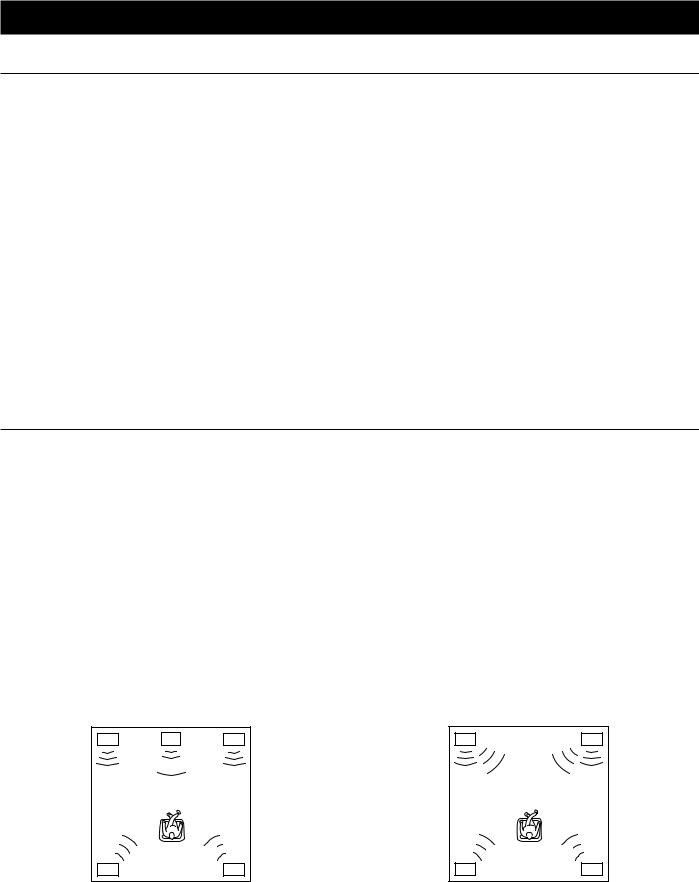
SPEAKER SETUP
SPEAKERS TO BE USED
This unit is designed to provide the best sound-field quality with a 5-speaker configuration, using main speakers, rear speakers and a center speaker.
The main speakers are used for the main source sound plus the effect sounds. They will probably be the speakers from your present stereo system. The rear speakers are used for the effect and surround sounds, and the center speaker is for the center sounds (dialog, vocals, etc.). If for some reason it is not practical to use a center speaker, you can do without it. Best results, however, are obtained with the full system.
The main speakers should be high-performance models and have enough power-handling capacity to accept the maximum output of your audio system.
The other speakers do not have to be equal to the main speakers. For precise sound localization, however, it is ideal to use high-performance models that can reproduce sounds over the full-range for the center speaker and the rear speakers.
Use of a subwoofer expands your sound field
It is also possible to further expand your system with the addition of a subwoofer and amplifier. The use of a subwoofer is effective not only for reinforcing bass frequencies from any or all channels, but also for reproducing the LFE (low frequency effect) sound with high fidelity when playing back a source that is Dolby Digital-decoded. You may wish to choose the convenience of a YAMAHA Active Servo Processing Subwoofer System, which has its own built-in power amplifier.
SPEAKER CONFIGURATION
5-Speaker Configuration
This configuration is the most effective and recommended one. When playing back a source using the DSP program,
DOLBY PRO LOGIC/DOLBY DIGITAL, DOLBY PRO LOGIC ENHANCED/DOLBY DIGITAL ENHANCED, 70 mm MOVIE THEATER/DIGITAL MOVIE THEATER, MONO MOVIE or TV SPORTS, or when playing back a source which contains center-channel signals (dialog, vocals, etc.) using any DSP program that is Dolby Digital-decoded, conversations will be output from the center speaker and the ambience will be excellent.
Note: Set the CNTR (CENTER SPEAKER) mode to the “LARGE” or “SMALL” position. (See page 21 for details.)
4-Speaker Configuration
The center speaker is not used in this configuration. When playing back a source using the DSP program, DOLBY PRO LOGIC/DOLBY DIGITAL, DOLBY PRO LOGIC ENHANCED/ DOLBY DIGITAL ENHANCED, 70 mm MOVIE THEATER/ DIGITAL MOVIE THEATER, MONO MOVIE or TV SPORTS, or when playing back a source which contains center-channel signals (dialog, vocals, etc.) using any DSP program that is Dolby Digital-decoded, the center sound is output from the left and the right main speakers. However, the sound effect of other programs will be the same as that of the 5-speaker configuration.
Note: Be sure to set the CNTR (CENTER SPEAKER) mode to the “NONE” position. (See page 21 for details.)
Main L |
Center |
Main R |
Main L |
Main R |
|
Dialog |
|
|
Dialog |
|
Surround sound |
|
Surround sound |
Rear L |
Rear R |
Rear L |
Rear R |
12
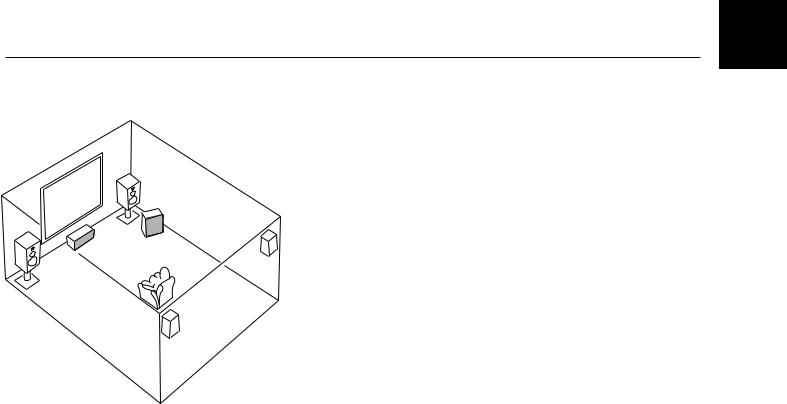
SPEAKER PLACEMENT
Refer to the following diagram when you place the speakers.
|
|
Main: |
The position of your present stereo speaker |
|
|
|
system. |
Main |
|
Rear: |
Behind your listening position, facing slightly |
speaker (R) |
|
||
|
|
|
inward. Nearly 1.8 m (approx. 6 feet) up from the |
Subwoofer |
|
|
floor. |
|
|
|
|
Center speaker |
Rear |
Center: |
Precisely between the main speakers. (To avoid |
speaker (R) |
|
interference with TV sets, use a magnetically |
|
|
|
|
|
Main |
|
|
shielded speaker.) |
speaker (L) |
|
|
|
|
|
Subwoofer: The position of the subwoofer is not as critical, |
|
|
|
|
because low bass tones are not highly directional. |
Rear |
|
|
|
speaker |
|
|
|
(L) |
|
|
|
English
13
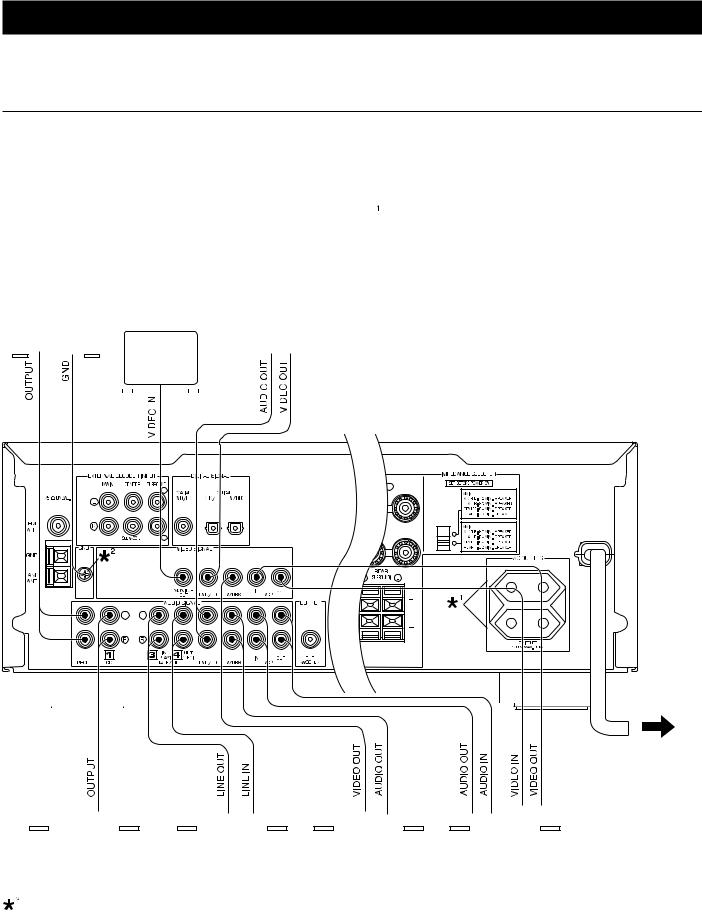
CONNECTIONS
Never plug in this unit and other components until all connections have been completed.
CONNECTIONS WITH OTHER COMPONENTS
When making connections between this unit and other components, be sure all connections are made correctly, that is to say L (left) to L, R (right) to R, “+” to “+” and “–” to “–”. Also, refer to the owner’s manual for each component to be connected to this unit.
*If you have YAMAHA components numbered as !, #, $, etc. on the rear panel, connections can be made easily by making sure to connect the output (or input) terminals of each component to the same-numbered terminals of this unit.
|
|
|
|
|
|
|
|
|
|
|
|
|
|
|
|
DVD player, |
|||||||||
Turntable |
Monitor TV |
|
LD player, etc. |
||||||||||||||||||||||
|
|
|
|
|
|
|
|
|
|
|
|
|
|
|
|
|
|
|
|
|
|
|
|
|
|
|
|
|
|
|
|
|
|
|
|
|
|
|
|
|
|
|
|
|
|
|
|
|
|
|
|
|
|
|
|
|
|
|
|
|
|
|
|
|
|
|
|
|
|
|
|
|
|
|
|
|
|
|
|
|
|
|
|
|
|
|
|
|
|
|
|
|
|
|
|
|
|
|
|
|
|
|
|
|
|
|
|
|
|
|
|
|
|
|
|
|
|
|
|
|
|
|
|
|
|
|
|
|
|
|
|
|
|
|
|
|
|
|
|
|
|
|
|
|
|
|
|
|
|
|
|
|
|
|
|
|
|
|
|
|
|
|
|
|
|
|
|
|
|
|
|
|
|
|
|
|
|
|
|
|
|
|
|
|
|
|
|
|
|
|
|
|
|
|
|
|
|
|
|
|
|
|
|
|
|
|
|
|
|
|
|
|
|
|
|
|
|
|
|
|
|
|
|
|
|
|
|
|
|
|
|
|
|
|
|
|
|
|
|
|
|
|
|
|
|
|
|
|
|
|
|
|
|
|
|
|
|
|
|
|
|
|
|
|
|
|
|
|
|
|
|
|
|
|
|
|
|
|
|
|
|
|
|
|
|
|
|
|
|
|
|
|
|
|
|
|
|
|
|
|
|
|
|
|
|
|
|
|
|
|
|
|
|
|
|
|
|
|
|
|
|
|
|
|
|
|
|
|
|
|
|
|
|
|
|
|
|
|
|
|
|
|
|
|
|
|
|
|
|
|
|
|
|
|
|
|
|
|
|
|
|
|
|
|
|
|
|
|
|
|
|
|
|
|
|
|
|
|
|
|
|
|
|
|
|
|
|
|
|
|
|
|
|
|
|
|
|
|
|
|
|
|
|
|
|
|
|
|
|
|
|
|
|
|
|
|
|
|
|
|
|
|
|
|
|
|
|
|
|
|
|
|
|
|
|
|
|
|
|
|
|
|
|
|
|
|
|
|
|
|
|
|
|
|
|
|
|
|
|
|
|
|
|
|
|
|
|
 SWITCHED AC OUTLET(S)
SWITCHED AC OUTLET(S)
Europe model ..................................... |
2 SWITCHED OUTLETS |
U.K. model ............................................ |
1 SWITCHED OUTLET |
Use these to connect the power cords from your components to this unit.
The power to the SWITCHED AC OUTLET(S) is controlled by this unit’s STANDBY/ON or the provided remote control transmitter’s POWER. These outlets will supply power to any component whenever this unit is turned on.
The maximum power (total power consumption of components) that can be connected to the SWITCHED AC OUTLET(S) is 100 watts.
(Europe model)
To AC outlet
|
|
|
|
|
|
|
|
|
|
|
|
|
|
|
|
CD player |
|
Tape deck, |
|
TV/DBS tuner |
VCR |
||
|
|
MD recorder, etc. |
|
|
(Video cassette recorder) |
||
GND terminal (for turntable use)
Connecting the ground (earth) wire of the turntable to the GND terminal will normally minimize hum, but in some cases, better results may be obtained with the ground wire disconnected.
14

CONNECTING TO VIDEO AUX TERMINALS (ON THE FRONT PANEL)
These terminals are used to connect any video input source, such as a camcorder, to this unit.
VIDEO AUX
Camcorder
CONNECTING TO AN EXTERNAL DECODER
When using the DTS or other decoder with 6-channel discrete outputs, connect the 6CH DISCRETE OUTPUT terminals of the decoder to the EXTERNAL DECODER INPUT terminals of this unit.
DTS or other decoder with 6-channel discrete outputs
L 

 L
L
R 

 R
R
(Europe model)
DVD player, LD player or other unit with digital outputs
English
15
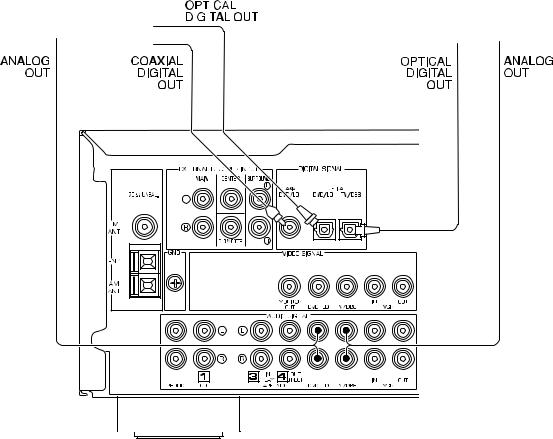
CONNECTING TO DIGITAL (COAXIAL AND/OR OPTICAL) TERMINALS
If your DVD (LD) player, TV/DBS tuner, etc. are equipped with coaxial or optical digital audio signal output terminals, they can be connected to this unit’s COAXIAL and/or OPTICAL digital signal input terminals.
To make a connection between optical digital audio signal terminals, remove the cover from each terminal, and then connect them by using a commercially available optical fiber cable that conforms to EIAJ standards. Other cables might not function correctly.
Even if you connect an audio/video unit to the COAXIAL (or OPTICAL) terminal of this unit, you must keep the unit connected with the same named analog audio signal terminals of this unit, because a digital signal cannot be recorded by a tape deck, MD recorder or VCR connected to this unit. You can easily switch the selection of input signals between “digital” and “analog”. (See page 28 for details.)
Notes
•When connecting an audio/video unit to both the digital and analog terminals of this unit, make sure to connect between terminals of the same name.
•Be sure to attach the covers when the OPTICAL terminals are not being used in order to protect them from dust.
•The input signal from the DVD/LD input terminals is selected in the following order of priority with the input mode set to the AUTO position:
1 COAXIAL terminal
2 OPTICAL terminal
3 Analog terminal
•All digital audio signal input terminals are applicable to sampling frequencies of 32 kHz, 44.1 kHz and 48 kHz.
•If your LD player has Dolby Digital RF signal output terminal, use the RF demodulator (separate purchase).
|
|
DVD or LD player |
|
|
|
|
TV/DBS tuner |
|||||||
|
||||||||||||||
|
|
|
|
|
|
|
|
|
|
|
|
|
|
|
|
|
|
|
|
|
|
|
|
|
|
|
|
|
|
|
|
|
|
|
|
|
|
|
|
|
|
|
|
|
|
|
|
|
|
|
|
|
|
|
|
|
|
|
|
(Europe model)
16
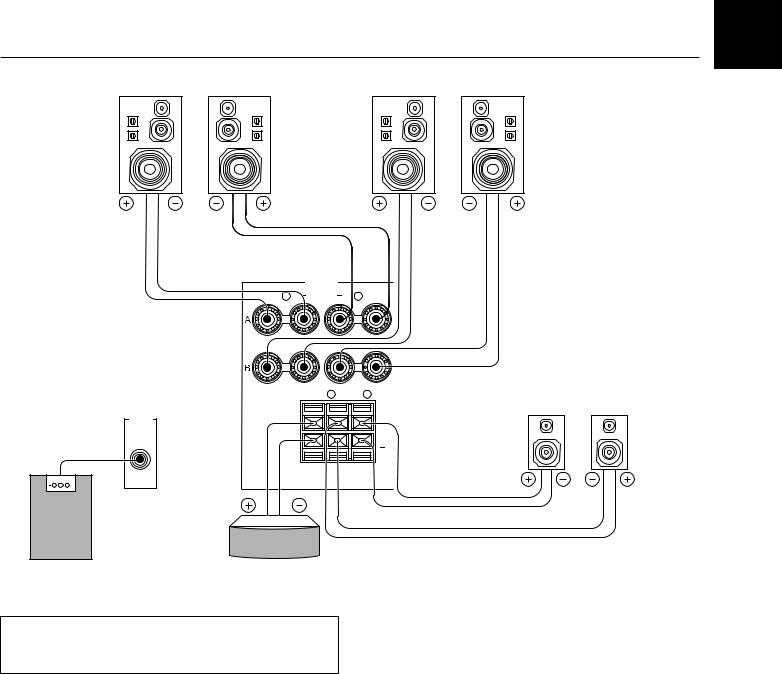
CONNECTING SPEAKERS
Main speakers A |
Main speakers B |
Right |
Left |
Right |
Left |
SPEAKERS
R |
MAIN |
L |
English
REAR
CENTER R (SURROUND) L
Rear speakers
OUTPUT
Left |
Right |
SUB
WOOFER
|
|
Subwoofer system |
Center speaker |
Note
Use speakers with the specified impedance shown on the rear panel of this unit.
Main speaker connections
One or two speaker systems can be connected to this unit. If you use only one speaker system, connect it to either of the SPEAKERS A or B terminals.
Rear speaker connections
A rear speaker system can be connected to this unit. Place them to the rear of your listening position.
Center speaker connection
A center speaker can be connected to this unit. Place it on or under the TV.
Subwoofer connection
You may wish to add a subwoofer to reinforce low frequencies or to output low bass sound from the subwoofer channel.
If you have a subwoofer with built-in amplifier, including the YAMAHA Active Servo Processing Subwoofer System, connect the SUBWOOFER OUTPUT terminal of this unit to the input terminal of the subwoofer system.
If you have a separate amplifier and subwoofer, connect the SUBWOOFER OUTPUT terminal of this unit to the input terminal of the subwoofer amplifier, and then connect the speaker terminals of the subwoofer amplifier to the subwoofer. When the input signals to this unit are for normal 2-channel stereo, this terminal outputs only frequencies below 90 Hz from the main and center channels. When discrete signals are input to this unit and are selected as the input source, this terminal outputs signals from the subwoofer channel.
Note: The output level of signals from this terminal is adjusted by VOLUME on the front panel or VOLUME ( 
 ) on the remote control transmitter.
) on the remote control transmitter.
17
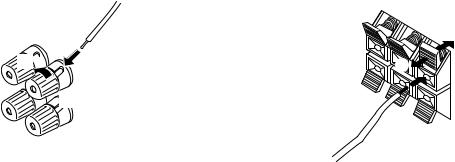
How to connect
Connect the SPEAKERS terminals to your speakers with wire of the proper gauge, cut as short as possible. If the connections are faulty, no sound will be heard from the speakers. Make sure that the polarity of the speaker wires is correct, that is the + and – markings are observed. If these wires are reversed, the sound will be unnatural and lack bass.
Caution
Do not let the bare speaker wires touch each other and do not let them touch any metal part of this unit. This could damage the unit and/or speakers.
Connecting to the MAIN SPEAKERS terminals
Red: positive (+)
Black: negative (–)
2
1
 3
3
1 Unscrew the knob.
2Remove approx. 5 mm (1/4”) of insulation from each of the speaker wires and insert the bare wire into the terminal.
3Tighten the knob to secure the wire.
Connecting to the REAR and CENTER SPEAKERS terminals
Red: positive (+) |
|
|
Black: negative (–) |
1 |
Press the tab. |
|
||
|
2 |
Remove approx. 5 mm |
|
1 |
(1/4”) of insulation from |
|
each of the speaker |
|
|
|
|
3 |
|
wires and insert the bare |
|
|
wire into the terminal. |
|
3 |
Release the tab to |
2 |
|
secure the wire. |
18
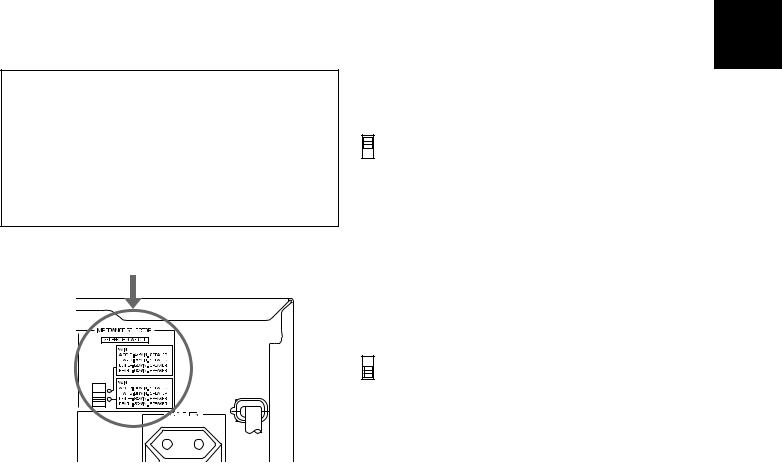
IMPEDANCE SELECTOR SWITCH
WARNING
Do not change the IMPEDANCE SELECTOR switch setting while the power to this unit is on, otherwise this unit may be damaged.
If this unit fails to turn on when the STANDBY/ON switch is pressed, the IMPEDANCE SELECTOR switch may not be fully set to either end. If so, set the switch to either end fully when this unit is in the standby mode.
IMPEDANCE SELECTOR
(Europe model)
English
Select the position whose requirements your speaker system meets.
(Upper position)
Main: If you use one pair of main speakers, the impedance of each speaker must be 4 Ω or higher.
If you use two pairs of main speakers, the impedance of each speaker must be 8 Ω or higher.
Center: The impedance of the speaker must be 6 Ω or higher.
Rear: The impedance of each speaker must be 6 Ω or higher.
(Lower position)
Main: If you use one pair of main speakers, the impedance of each speaker must be 8 Ω or higher.
If you use two pairs of main speakers, the impedance of each speaker must be 16 Ω or higher.
Center: The impedance of the speaker must be 8 Ω or higher.
Rear: The impedance of each speaker must be 8 Ω or higher.
19

ANTENNA CONNECTIONS
Each antenna should be correctly connected to the designated terminals, referring to the following diagram.
Both AM and FM indoor antennas are included with this unit. In general, these antennas will probably provide sufficient signal strength. Nevertheless, a properly installed outdoor antenna will give clearer reception than an indoor one. If you experience poor reception quality, an outdoor antenna may result in improvement.
Indoor FM
antenna Outdoor AM antenna
Outdoor FM antenna
(included)
AM loop antenna
75-ohm/300-ohm (included) antenna adapter
75-ohm coaxial cable
75-ohm/300-ohm antenna adapter
300-ohm feeder
Ground
Connecting the AM loop antenna
1 |
1 |
2 |
3 |
3
2
 Orient so that the best reception is obtained.
Orient so that the best reception is obtained.
*The AM loop antenna should be placed away from this unit. The antenna may be hung on a wall.
*The AM loop antenna always should be connected, even if an outdoor AM antenna is connected to this unit.
GND TERMINAL
For maximum safety and minimum interference, connect the GND terminal to a good earth ground. A good earth ground is a metal stake driven into moist earth.
Notes
•When connecting the indoor FM antenna, firmly insert its connector
into the FM ANT terminal.
• If you need an outdoor FM antenna to
improve FM reception quality, either 300-ohm feeder or coaxial
cable may be used. In locations
troubled by electrical interference, coaxial cable is preferable.
20
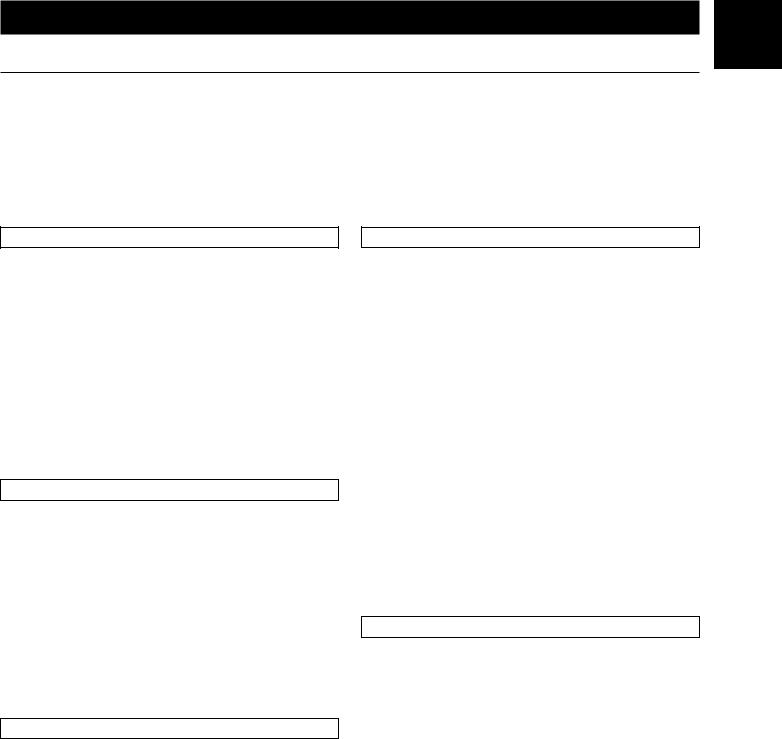
ADJUSTMENTS BEFORE USING THIS UNIT
SELECTING THE OUTPUT MODES
This unit provides you the following five functions to determine the method of distributing output signals to speakers suitable for your audio system. When speaker connections have all been completed, select the proper setting for each function to make the best use of your speaker system. (See “ADJUSTMENTS IN THE ‘SET MENU’ MODE” on page 47.)
1. CNTR (CENTER SPEAKER) |
2. REAR (REAR SPEAKERS) |
3. MAIN (MAIN SPEAKERS) |
4. BASS (LFE/BASS OUT) |
5. M.LVL (MAIN LEVEL) |
|
|
|
|
DESCRIPTION OF EACH FUNCTION
CNTR (CENTER SPEAKER)
Choices: LARGE/SMALL/NONE
Preset position: LARGE
LARGE: Select this position when your center speaker is approximately the same size as the main speakers.
SMALL: Select this position when you use a center speaker that is smaller than the main speakers.
In this position, low bass signals (below 90 Hz) on the center channel are output from the main speakers (or the SUBWOOFER OUTPUT terminal if the SMALL position is selected for “MAIN” and the SW position is selected for “BASS”).
NONE: Select this position when you do not have a center speaker. The center channel sound will be output from the left and right main speakers.
REAR (REAR SPEAKERS)
Choices: LARGE/SMALL
Preset position: LARGE
LARGE: Select this position if your rear speakers have high ability for bass reproduction, or a subwoofer is connected to the rear speaker in parallel.
In this position, full-range signals are output from the rear speakers.
SMALL: Select this position if your rear speakers do not have high ability for bass reproduction.
In this position, low bass signals (below 90 Hz) on the rear channels are output from the SUBWOOFER OUTPUT terminal (or the main speakers if the MAIN position is selected for “BASS”).
MAIN (MAIN SPEAKERS)
Choices: LARGE/SMALL
Preset position: LARGE
LARGE: Select this position if your main speakers have high ability for bass reproduction.
In this position, full-range signals present on the main channels are output from the main speakers.
SMALL: Select this position if your main speakers do not have high ability for bass reproduction. However, if your system does not include a subwoofer, do not select this position.
In this position, low bass signals (below 90 Hz) on the main channels are output from the SUBWOOFER OUTPUT terminal if the SW or BOTH position is selected for “BASS”.
BASS (LFE/BASS OUT)
Choices: SW/MAIN/BOTH
Preset position: SW
MAIN: Select this position if your system does not include a subwoofer.
In this position, full-range signals present on the main channels, signals from the LFE channel and other low bass signals that are selected for “CNTR” to “MAIN” to be distributed from other channels are output from the main speakers.
SW/BOTH:
Select either the SW or BOTH position if your system includes a subwoofer.
In either position, signals on the LFE channel and other low bass signals that are selected for “CNTR” to “MAIN” to be distributed from other channels are output from the SUBWOOFER OUTPUT terminal. When the LARGE position is selected for “MAIN”, in the SW position, no signal is distributed from the main channels to the SUBWOOFER OUTPUT terminal; however, in the BOTH position, low bass signals from the main channels are output to both the main speakers and the SUBWOOFER OUTPUT terminal.
M.LVL (MAIN LEVEL)
Choices: NRML (NORMAL)/–10 dB
Preset position: NRML (NORMAL)
NRML (NORMAL):
Normally select this position.
–10 dB: Select this position if the sound output from the main speakers is too loud and cannot be balanced with the sound output from the center and rear speakers. In this position, the sound output from the main speakers is attenuated.
English
21
